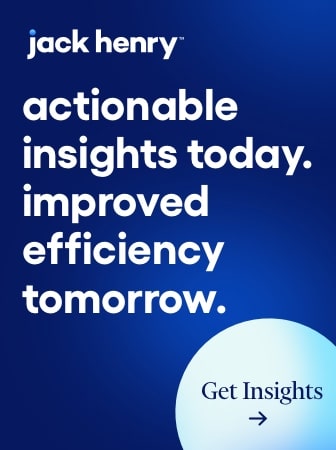In the rapidly evolving landscape of digital banking, financial institutions face a critical challenge: how to effectively leverage AI and process transformation to drive efficiency, enhance customer experiences and remain competitive. Sriram Natarajan, president of Quinte Financial Technologies, brings his wealth of expertise to the table in this thought-provoking discussion with Jim Marous on the Banking Transformed podcast.
Drawing upon his 30+ years of experience in cards, retail banking, consumer credit and risk management, Natarajan offers valuable insights into the importance of a process-centric approach to AI adoption, the need for balancing speed, security and compliance and the role of human expertise in driving successful digital transformation initiatives.
Throughout the conversation, Natarajan emphasizes the significance of focusing on tangible benefits and ROI rather than getting caught up in the hype surrounding new technologies.

Modern Customer Journey Mapping
Customers navigate a multi-touch, multi-channel journey before interacting with your brand. Do you deliver successful and seamless experiences at every touchpoint? Download webinar.

Register for Discovery2024 Conference
Join us August 8th for Discovery2024, your gateway to the strategic insights and human connections you may need to navigate the evolving financial landscape.
He provides practical guidance on prioritizing AI deployments, navigating regulatory challenges and avoiding common pitfalls that can derail transformation efforts.
As financial institutions grapple with the complexities of the current macroeconomic environment and the ever-increasing pace of technological change, Natarajan’s insights serve as a roadmap for those seeking to harness the power of AI and process transformation to drive meaningful, sustainable growth.
Listen: Generative AI in Banking: From Hype to Value Creation
The Impact of Macroeconomic Trends on Financial Institutions’ Digital Transformation Efforts
Q: How have the current macroeconomic trends affected financial institutions’ approach to digital transformation?
Sriram Natarajan: The current macroeconomic environment has created a bit of a dichotomy between commercial and consumer portfolios. While consumer mortgages have remained relatively stable, there is growing stress and delinquencies on the unsecured side of commercial portfolios.
Financial institutions are grappling with the challenges of managing risk, maintaining liquidity and adapting to new forms of credit like BNPL and app-based lending.
One of the biggest challenges for institutions in this environment is the cost of acquiring new customers and booking new loans. There’s also a lot of hype around technologies like gen AI, with institutions feeling pressure to keep up with the latest trends. This can create confusion and distract from the fundamental need to focus on processes and deliver tangible benefits to customers.
Q: What are some of the key challenges faced by smaller and midsize institutions when it comes to adopting new technologies like AI?
Natarajan: Smaller and midsize institutions often face resource constraints and legacy systems that can make adopting new technologies like AI difficult. They may struggle with deciding whether to rip and replace core systems or invest in middleware solutions to enable digital transformation.
Another challenge is the heavy dependence on manual processes and people, making it difficult to automate without streamlining and optimizing those processes. There’s often a gap between the front office and back office, with customer-facing digital implementations being easier to achieve than the more complex back-end transformations.
Prioritizing AI Deployment: A Process-Centric Approach
Q: How should financial institutions prioritize their deployment of AI solutions to ensure tangible benefits and ROI?
Natarajan: Institutions must avoid getting caught up in the hype around AI and instead focus on identifying areas where they can drive real, tangible benefits. This requires an honest assessment of their current processes and pain points and a willingness to start with smaller, more manageable implementations rather than attempting a big-bang approach.
One effective strategy is to target areas where the institution is already strong on the front end but needs to improve back-end support, such as digital onboarding or new product distribution. By focusing on processes that can deliver immediate efficiency gains or revenue growth, institutions can build momentum and gain buy-in for more extensive AI deployments over time.
Q: What role do process owners and human expertise play in the successful adoption of AI in banking?
Natarajan: Process owners and human expertise are essential to the success of any AI implementation in banking. The people currently running the processes must be actively involved in identifying areas for improvement and designing new solutions.
Too often, AI projects are driven by IT or innovation teams without sufficient input from the process experts who understand the day-to-day realities of the work.
By empowering process owners to lead the charge on AI adoption, institutions can ensure that new solutions are tailored to their specific needs and constraints. This approach also helps to build buy-in and engagement across the organization, as employees feel invested in the success of the initiatives rather than having change imposed upon them from above.
Balancing Efficiency, Customer Experience and Regulatory Compliance
Q: How can financial institutions strike a balance between the need for speed and the importance of security and regulatory compliance when implementing AI solutions?
Natarajan: Balancing speed and security is an ongoing challenge for financial institutions, particularly as regulators become more attuned to the risks associated with AI.
One approach is to adopt a parallel implementation strategy, where new AI solutions are tested on lower-risk processes that don’t directly impact customers, while existing systems continue to operate as usual.
As institutions gain confidence in the performance and reliability of these new solutions, they can gradually expand their scope to more critical processes.
It’s also important to stay abreast of evolving regulatory guidelines around AI, such as the EU’s proposed AI regulation and the UK’s digital regulation bill, to ensure compliance and mitigate potential risks.
Q: What are some best practices for financial institutions looking to leverage AI for improved back-office efficiency and customer experiences?
Natarajan: One key best practice is to start clearly understanding the institution’s biggest pain points and areas of opportunity. Rather than jumping on the latest tech bandwagon, focus on identifying processes where AI can deliver measurable improvements in efficiency, cost reduction, or customer satisfaction.
Another important consideration is data management. Many AI initiatives fail to deliver results because of poor data quality or siloed information. Investing in robust data governance and integration can lay the foundation for more successful AI deployments.
Finally, it’s essential to approach AI as an iterative, ongoing process rather than a one-time project. Continuously monitoring performance, gathering feedback and refining models over time can help institutions stay ahead of the curve and adapt to changing market conditions.
Avoid the Pitfalls of Hype and Focus on Tangible Benefits and Incremental Progress
Q: How can financial institutions avoid getting caught up in the hype surrounding new technologies like AI and instead focus on driving meaningful, incremental improvements?
Natarajan: It’s all too easy for institutions to get swept up in the hype around the latest technologies, whether it’s AI, blockchain, or the metaverse. However, it’s important to remember that hype doesn’t always translate into tangible benefits.
To stay grounded, institutions should focus on identifying specific use cases where AI can deliver measurable improvements in efficiency, cost savings, or customer experience. Start with small, targeted implementations and build from there, rather than trying to boil the ocean with massive, multi-year projects.
It’s also crucial to set clear metrics for success and track progress over time. This can help institutions stay accountable and avoid the temptation to chase after shiny objects that don’t deliver real value.
Q: What common mistakes or challenges financial institutions face when attempting to deploy AI solutions and how can they be mitigated?
Natarajan: One common mistake is failing to secure buy-in from key stakeholders, particularly those who will be most impacted by the changes. AI initiatives that are perceived as being driven by IT or external consultants without sufficient input from business users are more likely to face resistance and ultimately fail.
Another challenge is navigating the complex regulatory landscape around AI. Institutions need to be proactive in understanding and addressing issues like data privacy, bias and explainability to avoid running afoul of regulators.
Finally, many institutions underestimate the importance of change management and communication when deploying AI solutions. Employees may feel threatened by the prospect of automation or worry that their expertise is being devalued. Investing in training, support and clear communication can help ease these concerns and ensure a smoother transition.

Looking Ahead: The Future of AI in Banking
Q: As you examine the intersection of technology, data and people in banking, what opportunities do you see for financial institutions?
Natarajan: Despite the challenges, I see tremendous opportunities for financial institutions that are willing to embrace the potential of AI and other emerging technologies. By leveraging data and automation to streamline processes and deliver more personalized experiences, institutions can differentiate themselves in an increasingly competitive market.
One exciting area of growth is the use of AI to enable more proactive, predictive services. Rather than simply reacting to customer needs, institutions can use machine learning to anticipate issues and offer tailored solutions before problems arise.
Another opportunity lies in democratizing AI, making it more accessible to smaller institutions through partnerships, shared services and off-the-shelf solutions. As the technology becomes more ubiquitous, we may see a leveling of the playing field between large and small players.
Q: What advice would you give to financial institution leaders who are looking to embark on or accelerate their digital transformation journey?
Natarajan: My advice would be to start by clearly defining your institution’s biggest challenges and opportunities. What pain points are holding you back and where do you see the greatest potential for growth and improvement?
From there, develop a roadmap that balances short-term wins with long-term strategic objectives. Don’t try to do everything at once; instead, focus on building momentum through targeted, incremental improvements.
Finally, don’t underestimate the importance of people in the digital transformation process. Invest in training and upskilling your team, foster a culture of innovation and collaboration and always keep the end customer at the center of your efforts.
By approaching digital transformation as an ongoing journey rather than a destination and by staying focused on delivering tangible value through the intelligent application of technology and data, financial institutions can position themselves for success in the age of AI and beyond.
For a longer version of this conversation, listen to “Generative AI in Banking: From Hype to Value Creation” on the Banking Transformed podcast with Jim Marous. This Q&A has been edited and condensed for clarity.
Justin Estes is an award-winning writer, strategist, and financial marketing expert with expertise in banking, investments, and fintech. His clients include the NYSE, Franklin Templeton, Credit Karma, Citi and, UBS, and his work has appeared in Forbes, Barrons and ThinkAdvisor as well as The Financial Brand.







